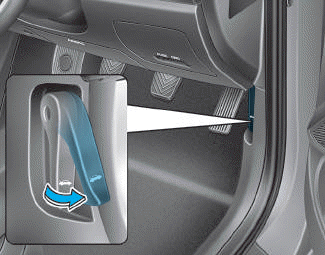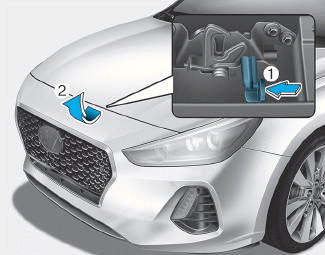Hyundai i-30: Engine Control System / Accelerator Position Sensor (APS)
Hyundai i30 (PD) 2018-2025 Service Manual / Engine Control / Fuel System / Engine Control System / Accelerator Position Sensor (APS)
Description and operation
| Description |
Accelerator Position Sensor (APS) is installed on the accelerator pedal module
and detects the rotation angle of the accelerator pedal. The APS is one of the
most important sensors in engine control system, so it consists of the two sensors
which adapt individual sensor power and ground line. The second sensor monitors
the first sensor and its output voltage is half of the first one. If the ratio
of the sensor 1 and 2 is out of the range (approximately 1/2), the diagnostic
system judges that it is abnormal.

Specifications
| Specification |
|
Accelerator Position |
Output Voltage (V) |
|
|
APS1 |
APS2 |
|
|
C.T |
0.7 - 0.8 |
0.325 - 0.425 |
|
W.O.T |
3.98 - 4.22 |
1.93 - 2.17 |

Schematic diagrams
| Circuit Diagram |

Harness Connector

Repair procedures
| Inspection |
| 1. |
Connect the diagnostic tool to the Data Link Connector (DLC).
|
| 2. |
Turn the ignition switch ON.
|
| 3. |
Measure the output voltage of the APS 3 and 6 at C.T and W.O.T.
|
 Heated Oxygen Sensor (HO2S)
Heated Oxygen Sensor (HO2S)
Description and operation
Description
Heated Oxygen Sensor (HO2S) consists of zirconium and alumina and is installed
both upstream and downstream of the Manifold Catalytic Converter...
 Rail Pressure Sensor (RPS)
Rail Pressure Sensor (RPS)
Description and operation
Description
Rail Pressure Sensor (RPS) is installed on the delivery pipe and measures the
instantaneous fuel pressure in the delivery pipe...
Other information:
Hyundai i30 (PD) 2018-2025 Owner's Manual: Fuses
A vehicle’s electrical system is protected from electrical overload damage by fuses. This vehicle has 2 (or 3) fuse panels, one located in the driver’s side panel bolster, the other in the engine compartment. If any of your vehicle’s lights, accessories, or controls do not work, check the appropriate circuit fuse...
Hyundai i30 (PD) 2018-2025 Service Manual: Front Seat Assembly
Components and components location Component Location 1. Front seat assembly Repair procedures Replacement 1. Open the cover and loosen the front seat mounting bolts...
Categories
- Manuals Home
- 3rd Generation i30 Owners Manual
- 3rd Generation i30 Service Manual
- EPB malfunction indicator
- Engine coolant
- Auto door lock/unlock features
- New on site
- Most important about car
Bonnet
Opening the bonnet

1. Park the vehicle and set the parking brake.
2. Pull the release lever to unlatch the bonnet. The bonnet should pop open slightly.

Copyright © 2025 www.hi30.net
